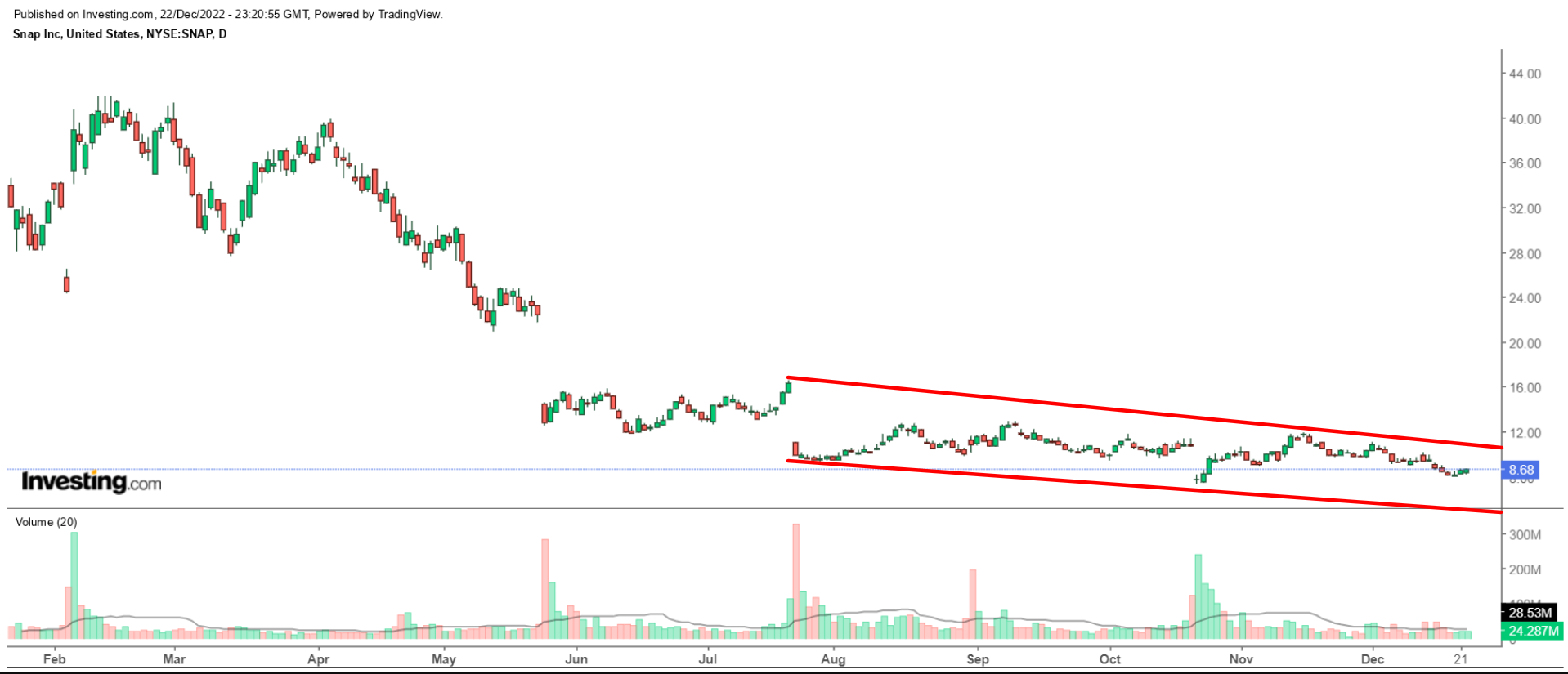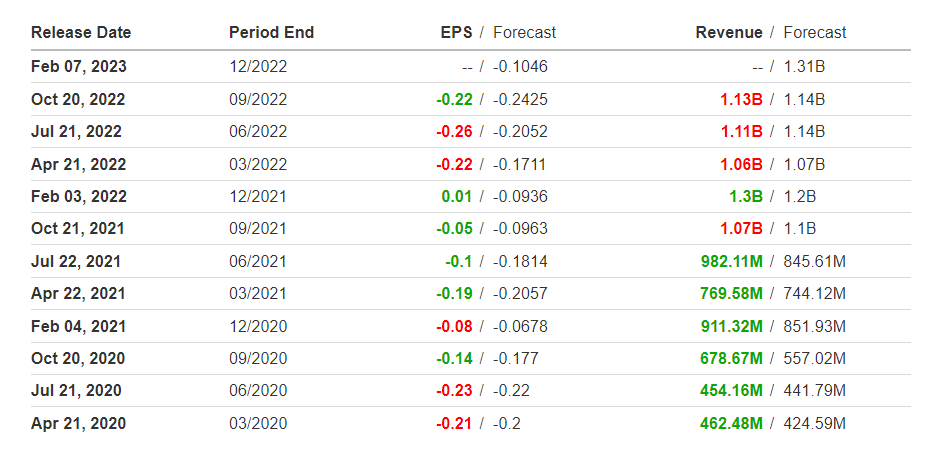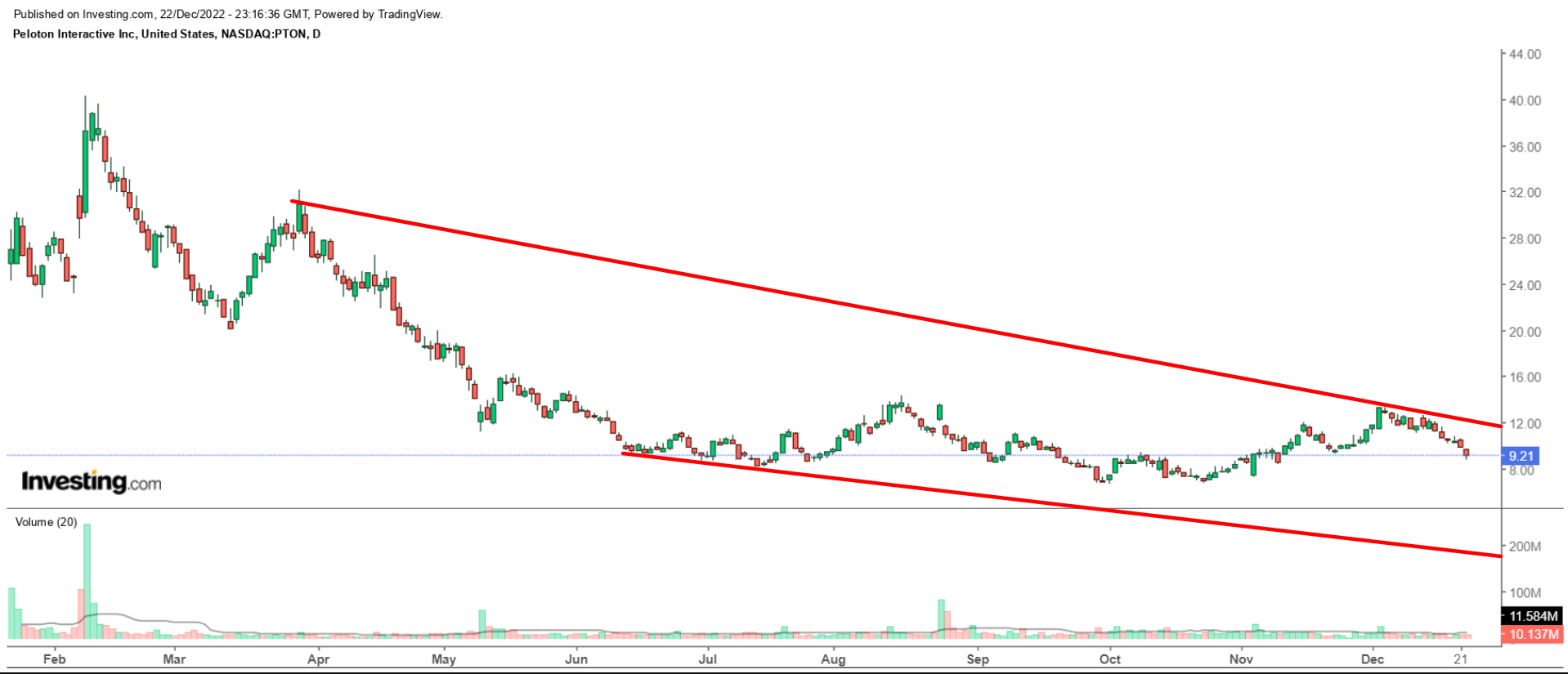- 2022 was a brutal year for the S&P 500, and it is down almost 20% year-to-date
- A triple whammy of rising interest rates, soaring inflation, and recession fears hammered growth stocks
- Investors should avoid Snap and Peloton as the selloff continues in 2023
- Year-To-Date Performance: -81.5%
- Market Cap: $14 Billion
- Year-To-Date Performance: -74.2%
- Market Cap: $3.1 Billion
In sharp contrast to Wednesday’s article in which I highlighted Occidental Petroleum (NYSE:OXY) and Lockheed Martin (NYSE:LMT) as two year-to-date winning stocks to hedge against further downside volatility next year, below I take a look at two of 2022’s biggest losers which you ought to avoid with further turmoil expected.
1. Snap
Snap (NYSE:SNAP) has seen its valuation collapse in 2022 due to various headwinds, such as slowing digital-advertising spending and increased competition from companies like TikTok. The ad-reliant social media firm has also struggled in the face of Apple’s (NASDAQ:AAPL) crackdown on ad tracking across iOS apps.
In addition to worsening fundamentals, Snap has been negatively impacted by the rough economic environment of rising interest rates, elevated inflation, and worries about a looming recession.

After climbing to an all-time high of $83.34 in September 2021, SNAP stock, which is down 81.5% year-to-date, dropped rapidly to hit a near four-year low of $7.33 on Oct. 21. Shares closed at $8.68 on Thursday, roughly 90% below their record peak.
At current valuations, the parent company of the social media messaging app Snapchat has a market cap of $14 billion, well off its peak of $136 billion.
There isn’t much to like about Snap. Despite the year-long selloff, Snap’s stock is still overvalued as it trades at more than 25 times this year’s sales, making it a less attractive option amid the current market environment.
I anticipate headwinds in the advertising industry to worsen in 2023 as corporations and small businesses continue to cut back on ad spending in a slowing economy.
That does not bode well for Snap’s monetization efforts, which will likely prolong its path to profitability and heighten its execution risk.
As a result, I see the Santa Monica, California-based company - which has managed to turn a profit only once since going public in 2017 - suffering through another challenging year of slowing profit and sales growth amid a weak performance in its core ads business. 
Taking that into account, SNAP is vulnerable to further losses in the year ahead as it continues to reel from an uncertain macro-outlook and deteriorating fundamentals resulting in privacy changes in Apple’s iOS and growing competition from Chinese video-sharing app TikTok.
2. Peloton
Widely viewed as one of the big winners of the 2020 COVID outbreak, Peloton (NASDAQ:PTON) has since fallen out of favor due to a toxic combination of shrinking demand for its at-home fitness products, ongoing supply chain issues, worries about a possible recession, and rising Fed interest rates.
In general, expectations of tighter monetary policy tend to weigh heavily on non-profitable companies with lofty valuations, as rising rates threaten to erode the value of their longer-term cash flows.

Year-to-date, Peloton shares have crashed by roughly 74% and are about 95% away from their all-time high of $171.09 touched in January 2021. PTON stock, which began the year at $35.26 before falling to a record low of $6.66 on Oct. 3, ended Thursday’s session at $9.21.
At current levels, the New York-based interactive fitness company, which sells stationary bicycles and treadmills that allow monthly subscribers to remotely participate in classes via streaming media, has a market cap of $3.1 billion, compared to a peak valuation of nearly $50 billion in early 2021.
In my opinion, Peloton’s stock is set to suffer further turmoil in 2023 as the home exercise equipment maker faces a challenging environment that is seeing it burn through high levels of cash amid rising cost pressures and declining operating margins.
Peloton has missed top-line estimates for six consecutive quarters while trailing revenue expectations five times in that span, reflecting the negative impact of several headwinds on its business.
Peloton has also struggled in the face of a difficult macroeconomic backdrop of increasing interest rates, accelerating inflation, and slowing growth.

Looking ahead, Peloton’s management recently warned that the challenging macro environment could hinder the company’s goal of achieving breakeven cash flow in the second half of fiscal 2023.
The disappointing guidance tells me that Peloton is still struggling to deliver on its turnaround plan, adding to fears over the long-term growth prospects of the distressed fitness equipment maker.
I have a hard time seeing Peloton regain its footing in a post-pandemic world. Overall, I remain bearish on PTON and believe there are material risks to its outlook, which could push shares down to fresh lows in the year ahead.
Disclosure: At the time of writing, Jesse is short on the S&P 500 and Nasdaq 100 via the ProShares Short S&P 500 ETF (SH) and ProShares Short QQQ ETF (PSQ). He is long on the Energy Select Sector SPDR ETF (XLE) and the Health Care Select Sector SPDR ETF (XLV).
The views discussed in this article are solely the author's opinion and should not be taken as investment advice.
